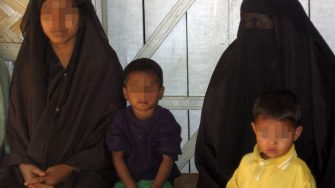Identifying the impacts of sexual and gender-based violence
Module 5
Module 5

Even now, the silence and denial about sexual and gender-based violence (SGBV) experienced by refugee women is deafening.
There are many complex reasons for this – see suggested readings. As stakeholders in the refugee world, we all have a responsibility to do something about this. To know that human rights abuses are being perpetrated, and to ignore or deny them makes us complicit in the actions. Women face SGBV as part of conflict, as a way of humiliating the men in their communities, as genocide, while crossing borders, in exchange for food and non-food items for their families. Many refugee women are forced at some point to work in survival sex in order to survive.
Child and youth marriage is much higher in refugee communities, not only because of cultural reasons, but because of absolute poverty, and as a way of protecting young single girls from rape. Many girls and women bear children of rape.
In every site in which we have worked in this project and 22 other countries over the 25 years, women have identified rape, gender-based violence and sexual harassment (SGBV) as THE major barrier to participation, and gender equality in all aspects of their lives.
The main aim of this module is to ensure that all stakeholders recognise and acknowledge the huge impact that SGBV has on women’s ability to meaningfully participate in all aspects of their lives, their families and communities, and to identify effective ways to address this.
We suggest that you allocate a minimum of half a day to undertake the Matrix exercise and a further half day to do storyboarding.
While there are many excellent definitions of SGBV, this covers the approach we have taken:
Sexual violence is a form of gender-based violence and encompasses any sexual act, attempt to obtain a sexual act, unwanted sexual comments or advances, or acts to traffic, or otherwise directed against a person’s sexuality using coercion, by any person regardless of their relationship to the victim, in any setting. Sexual violence takes multiple forms and includes rape, sexual abuse, forced pregnancy, forced sterilization, forced abortion, forced prostitution, trafficking, sexual enslavement, forced circumcision, castration and forced nudity.
This PowerPoint presentation will take the group through the rationale for the module, and introduce the Tools and exercises which will help identify the different experiences of SGBV endured by diverse groups of women and girls, men and boys. It is important that you spend sufficient time on these exercises, and use both the Matrix to identify problem areas and Storyboards to identify solutions. Please familiarise yourself with the background readings and suggestions in the slide notes before presenting the slides. The exercises can be very confronting, and you need to be prepared for your response and the response of the participants.
The UNSW age gender diversity matrix tool introduced in module 4, age gender and diversity.
You may wish to use the entire matrix, for example in 2018, we conducted consultations with over 400 refugees and 100 local stakeholders, in Thailand, Malaysia and Bangladesh examining barriers to gender equality in a number of key thematic areas. As can be seen here, SGBV crosscuts almost all issues and diverse groups. (For full details see Project Report 2022).
You may just want to focus on this one issue:
Gauging the occurrence and impact of SGBV in any given site.
We have found Storyboarding, (which is part of the reciprocal research package) to be an excellent tool for working with refugee communities to analyse situations and suggest solutions.
The exercise moves from problem identification, (which is done in the matrix exercise) to problem solving and is an excellent way to engage members of refugee communities in identifying appropriate local solutions.
The same exercises are equally important to use with all stakeholders, and the most value is gained when the results from each group involved are brought together to inform program design, implementation and evaluations.